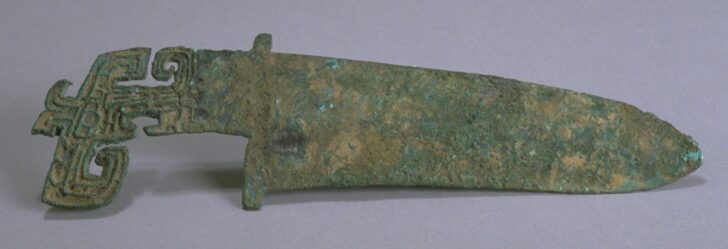Ge (ceremonial dagger-axe)
Chinese

Description
Metalworking emerged around 2000 BCE in China, with bronze vessels appearing around 1600 to 1500 BCE in what is known as the Shang dynasty (DATES). Shang society followed the Neolithic societies of Northern China and is the first historically recorded civilization of China. Chinese writing was invented by the Shang and the short inscriptions they left on oracle bones and bronze vessels, along with extensive excavations, show a complex and highly organized society headed by a king and his family, administered by officials, and serviced by craftsmen, slaves, and prisoners of war. The dynasty occupied three capitals in Henan province, the last of which, Anyang, (ca. 1300-1050 BCE) was located south of present-day Beijing. It was in Anyang that some of the world’s greatest masterpieces of bronze art came into being.
The main weapon of war in the Shang was the ge, which is a halberd with a knife-shaped bronze blade mounted at right angles to a long wooden shaft. These dagger-axes came in different forms, and this particular example, with a tang decorated in the shape of a stylized bird was probably for ceremonial display rather than combat. Shang warriors also used bows and bronze arrows and fought from mounted chariots after their move to Anyang around 1300 BCE.
(Label for UMMA Chinese Gallery Opening Rotation, March 2009)
Subject Matter:
ceremonial bronze ge dagger-axe of Middle Shang to early Late Shang Shang period, frequently seen in the tombs of elite warriors. The zoomorphic tang is decorated with stylized bird motif. Its elaborate design suggests that it was probably for ceremonial display rather than combat. The zoomorphic tang is decorated with stylized bird motif. Similar objects is seen in the tomb of royal lady Fu Hao of early Late Shang, excavated in Anyang (Plate LXXII). Institute of Archaeology, CASS 1986. Yinxu Fuhao mu (Tomb of Lady Hao at Yinxu in Anyang). Beijing: Wenwu Press.
Physical Description:
ceremonial bronze ge dagger-axe, with pointed blade on one end and zoomorphic tang of stylized bird motif on the other.
Usage Rights:
If you are interested in using an image for a publication, please visit https://umma.umich.edu/request-image/ for more information and to fill out the online Image Rights and Reproductions Request Form.